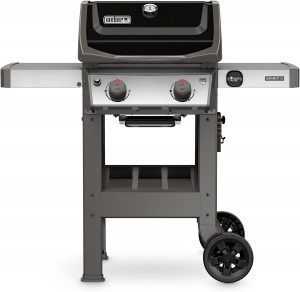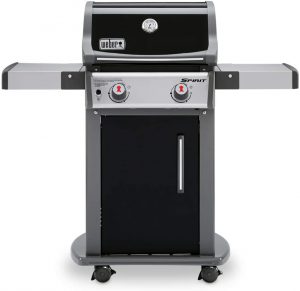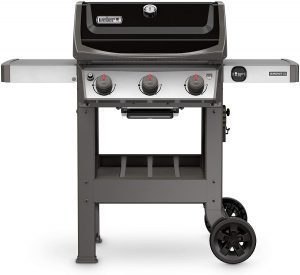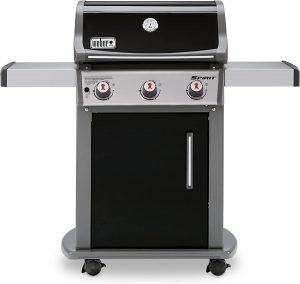Weber E-210 vs E-310, which one is the best? It’s the hard nut to crack when you want to decide between the most loved series of grills that Weber has ever produced.
Weber is a renowned company when it comes to grills. And Weber’s E 210 and E 310 have become so popular that you can find any of these in every home. But which for you?
There are many grills in each series, and it becomes difficult to distinguish between different models even in the same series. In this guide, we aim to demystify the confusion between the two series and draw a line between them. We’ll also provide a detailed outlook on all models in each series so that you can decide which one to choose for your grilling needs.
Weber E-210 vs E-310 Grills: Key Difference

When it’s about Weber E 210 vs E 310, the main difference is the number of burners on each grill. All 210 models have two burners, while all models in the E310 series have three burners on them. Weber’s terminology is simple, i.e., the first digit on the individual model name indicates the number of burners on that model.
The number of gas burners on a specific model hints at the cooking space that the model provides. Since E-210 models have only two burners, they have less cooking area than E-310 models. All E-210 grills are also smaller than the E-310 ones.
Another implication of the number of gas burners relates to direct heat output. A small number of burners correlate to less heat output. If you’re a professional griller or someone who cooks regularly, you might want to get a model with more burners and, in turn, more heat output.
Difference between the Weber E and S series
In this guide, we’re only looking at the Weber E series. But there’s a Weber S series as well. The main difference between the two grills of the same series is that all Weber E models have porcelain enameled cast iron grates, while the S models come with stainless steel grates.
It’s better to know in the first place that all models discussed in our guide come with porcelain-enameled grates because they fall in the Weber E category.
Difference between Weber Spirit vs Genesis

Weber Spirit and Weber Genesis are the basic categories when it comes to Weber’s taxonomy system. A Weber grill may be available in either a Spirit or Genesis model or both.
When we compare Weber Spirit and Genesis models, it becomes apparent that the latter is more advanced and loaded with extra features than the former. However, it doesn’t imply that the Spirit series grills lack any essential features or enhancements. It’s just that most connoisseurs prefer Genesis grills over Spirit models.
Similarities between Weber Spirit and Genesis
Being products of Weber, both grills share the following similarities:
-
Warranty
Both grill series come with a 10-year warranty.
-
GS4 Grilling System
Both grill series feature Weber’s GS4 Grilling System. This system includes Infiniti ignition, flavorizer bars, advanced grease management, and upgraded burners. The Infiniti ignition system works in all weather conditions and never fails. Triangular flavorizer bars reduce flare-ups by trapping drippings, which later add smoke to the food. The advanced grease management system refers to an easy-to-clean, disposable drip tray that sits beneath the burners. Upgraded burners ensure even cooking by keeping the temperature consistent all over the cooking surface.
-
I Grill Technology
Both series are equipped with iGrill 3 technology. This technology allows you to monitor and control your grill via a smartphone app.
-
Colors Availability
Both series come in two color variants, i.e., stainless steel and black. You can select between colors for the same models. You can also choose between propane and natural gas options for the same model.
Differences between Weber Spirit and Genesis
-
Price Difference
Spirit grills are cheaper than their Genesis counterparts.
-
Features Variation
Genesis grills are loaded with extra, high-end features.
E-210: Difference between Spirit I, Genesis I, Spirit II, Genesis II Grills
Both Spirit and Genesis grills have I and II generations. The main difference between the two generations is that the first-generation Weber grills have an enclosed storage area. The Spirit I and Genesis I grills look like enclosed carts.
In addition, the Spirit II and Genesis II models feature bare bone construction supported by legs on wheels. These grills have an open storage area.
The Weber E-210 series comprises only two models, i.e., Spirit II E-210 gas grill and Spirit E-210 gas grill. The former features a bare bone construction, while the latter boasts an enclosed-cart style. There are no Genesis models in the Weber E-210 lineup.

The grill features a sleek design to fit into compact places, such as an apartment or patio. However, the compact construction of this grill doesn’t compromise any features Weber is known for. This grill comes with a GS4 grilling system and is compatible with iGrill thermometers.
Weber Spirit II E-210 has innovative flavorizer bars that smoke excess oil and food drippings to enhance the food’s flavor. This effective grease management system carries away the extra food drippings from the burners.
The grill comes with non-stick, double-sided, porcelain-enameled grates. You can use either thin, thick, or both grates for a versatile grilling experience.
The grill boasts an open-cart design with side tables. A total of six hooks on side tables allow you to keep all your cooking tools within arm’s length. You can also fold down the left table to save space.
There’s a built-in lid thermometer and fuel gauge on the grill. The grill has two burners with a total heat output of 26,500 BTU per hour. And the entire cooking area is of 450 square inches, which includes 360 square inches as the primary cooking surface and a warming rack of 90 square inches. Overall, this grill is easy to use, budget-friendly, and packed with all the features you need as a griller.

This grill is almost similar to the previously reviewed Spirit II model, except it has received enhancements and an enclosed-cart design. There are other differences, too; for example, both of its side tables can be folded down and retracted with the push of a button. It has a high-quality and durable cook box that hosts two porcelain-enameled cast-iron grates.
These grates retain even heat for a long time and also last longer. It has a porcelain enameled lid with a built-in thermometer. The grill has six tool hooks that resemble the Spirit II E-210 ones.
One of the most significant changes in this model is a warming rack of about 90 square inches. It stands above the main grilling area, and you can use it for toasting burger buns and keeping the food warm while the main meal is being grilled below.
Since the Spirit E-210 is also a 2-burner gas grill, it delivers 26,500 BTUs of heat per hour. The total cooking surface is similar to the Spirit II E-210, i.e., 450 square inches, consisting of a primary cooking area of 360 square inches and a warming rack of 90 square inches.
It has a fuel gauge to inform you about the fuel reservoir on time. A propane tank fuels the grill.
The grill has two swivel casters for easy maneuvering and two swivel locking casters for holding the grill in place.
This model is priced higher than the Spirit II model of the same grill. It also lacks certain features; for example, it doesn’t support the iGrill Bluetooth thermometer. But if you prefer a compact closed-cart design, this grill is the best entry-level option for you.
Weber E-310: Difference between Spirit I, Genesis I, Spirit II, Genesis II Grills
In the Weber E-310 lineup, we’ll be discussing the Spirit E-310 gas grill, the Spirit II E-310 gas grill, and the Genesis II E-310 gas grill. The grills are fueled by a 20 lbs. propane tank. However, there are natural gas models of these grills as well.
Since the Weber E-310 natural gas grills are identical to their respective LP models except for the connections, this guide remains limited to reviewing LP grills alone.
So, in total, the Weber E-310 lineup has six grills. And we’ll be reviewing their LP versions here.

This grill comes in open-cart style, allowing you to manage the storage space easily. It has all the features of the Spirit line, one more burner, and high heat output. It has side tables with integrated tool hooks and allows you to fold the left table down with a mere push of a button.
It features porcelain enameled glamorizer bars as well as non-stick, cast-iron grates for excellent heat retention.
The GS4 grilling system comprises an improved infinity ignition, burners, flavorizer bars, and grease management system.
While a built-in lid thermometer is present in the grill, you can remotely access and monitor your grill’s temperature with the iGrill thermometer. However, this accessory is sold separately.
The Weber Spirit II E-310 has a total heat output of 30,000 BTUs per hour. Thus, it delivers more heat than any of the Spirit E-210 models. The reason for this is apparent. It has three main burners, while the E 210 models have only two.
This grill has a primary cooking area of 424 square inches instead of the E-210 models, all of which have a primary cooking area of 360 square inches. Additionally, it has a warming rack of 105 square inches, as opposed to the 90” of the E-210 lineup. The total cooking area of this grill is 529 square inches, as opposed to the 450” of the Spirit E-210 models.
This grill has two sturdy wheels on the right. You can use the left side table as a handle to raise the side a little bit and move the grill. The right legs keep the grill in place when you’re cooking.
The Weber Spirit II E-310 grill costs about $100 more than its respective E-210 model. If you want more heat, this grill is worth the price.

This grill is priced about $150 higher than the Weber Spirit II E-310 gas grill despite having almost similar features and specifications as the Spirit II E-310. However, the main difference between the two models is the design and heat output.
This grill has an enclosed-cart design with a grill cabinet secured through painted steel doors. In the same way, and front-access grease tray is also an appreciable feature of this grill.
this Weber’s grill features a total cooking area of 529 inches, which includes a warming rack of 105” and a primary cooking surface of 424 square inches. It has three stainless steel burners with a total heat output of 32,000 BTUs per hour. So it delivers 2000 BTUs of more heat than the Spirit II E-310 model.
This grill, too, like all Spirit and Genesis grills, has a built-in temperature gauge on the lid.
The grill has two swivel casters as well as two locking caster wheels.
There are no marked differences between the Spirit E-310 and the Spirit II E-310 gas grills except for the design and heat output.

This grill is the most advanced and feature-rich model in the entire series. It has more heat capacity, more cooking area, and more storage space. The Weber Genesis II E-310 grill comes in an open-cart style to provide easy accessibility to your grilling tools. The only feature missing is the ability to fold the left or both side tables. However, if you go for a heavy grill like this, it’s reasonable to assume that you have enough space.
The grill provides a total heat output of 39,000 BTUs per hour. The total cooking area is 669 square inches, consisting of a primary cooking surface of 513 and a warming rack area of 156 square inches.
One of the most exciting things on this grill is a Tuck-Away warming rack. You can fold the warming rack down when you don’t need it for easy storage.
Would you care about rotisserie kit compatibility in the future? Remember, your grill might last over 10-15 years. And soon, you’ll be wishing for rotisserie compatibility. The good news is that this model of E-310 can adapt to a rotisserie kit as well, which none of the E-210 or E-310 can.
According to us, it’s a win!
Weber E-210 vs E-310 – Key Takeaways and Buyer’s Guide
The following are the key takeaways when comparing Weber E-210 vs. E-310 models:
- Weber E-310 grills are more feature-rich, high-end, durable, and costlier than their respective E-210 models.
- E-310 grills have an additional burner, high heat capacity, and more cooking space than the E-210 models.
- All Spirit models in both series come in enclosed-cart styles and are priced higher than the Spirit II grills.
- The Spirit II models in both lines have open-cart designs and are relatively cheaper than the Spirit models.
- Genesis models are priced higher than the Spirit models.
- Genesis II E-310 grill is the most advanced and feature-rich model than all other grills in both series, like rotisserie kit and warming rack.
- All E-210 and E-310 series models have a built-in lid thermometer, swivel casters, GS4 grilling system, a fuel gauge, side tables, and six tool hooks.
Weber E-210 vs E-310: How to Choose yours
You have to consider many things before making a purchase. In Weber’s case, all of their grills reflect state-of-the-art creativity and originality. Weber grills are long-lasting, have advanced features, and serve your grilling needs very well. For these reasons, the difference becomes subtle and so often goes unnoticed.
-
Consider your grilling needs.
First of all, you should never overlook your grilling needs. There is no need to purchase a 3-burner E-310 grill unless you are a connoisseur or cook for a large circle of family and friends. Likewise, for your ease, you can also keep the additional features of your grill in view like storage, side burner, hooks, etc.
-
Pay attention to overall grill dimensions.
Second, buy a grill that can easily fit into the space you have and still spares some room for you. E-210 grills are smaller and take up less space than their E-310 counterparts. Similarly, all Spirit grills are smaller than their respective Genesis models. Also, remember that the Spirit and Genesis models are larger than their corresponding Spirit II and Genesis II models.
-
Choose the grill’s color according to your taste.
Third, Weber grills come in either black or stainless steel construction and sometimes in multiple color options. Choose according to your taste and aesthetics.
FAQs
-
When did the Weber Spirit E 310 come out?
The Weber Spirit E-210 was introduced in 2018.
-
How hot does the Weber Spirit E 310 get?
The maximum temperature the Weber Spirit E-310 reaches is between 500° and 550° F.
-
Does the Weber Spirit II E-210 come in natural gas?
No, there is no natural gas model available for the Weber Spirit II E-210. However, you can call a plumber to connect it to your natural gas pipeline, and it will work well.
Weber E-210 vs E-310 Spirit II: Which is Better? Our Verdict
The Weber E-210 vs E-310 grills have three rivals fighting to determine the best for your cooking experiment. The Weber Spirit II E modified is better than the Spirit 210. Likewise, Genesis E-310 is better than the Spirit II E- 310 and the Spirit E-310 despite not being enclosed. Yet, it’s compatible with the rotisserie kit, which the rest of the 4 grills lack. Don’t forget to let us know which one fits your needs. You can use the comment section below.
universitygrill.net is a participant in the Amazon Associate program and will earn from qualifying purchases.
